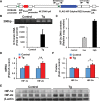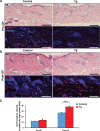Overexpressed HIF-2α in Endothelial Cells Promotes Vascularization and Improves Random Pattern Skin Flap Survival
- PMID: 25289325
- PMCID: PMC4174206
- DOI: 10.1097/GOX.0000000000000083
Overexpressed HIF-2α in Endothelial Cells Promotes Vascularization and Improves Random Pattern Skin Flap Survival
Abstract
Background: The local skin flap procedure is very useful for reconstruction. However, flap necrosis caused by circulatory failure can occur at its distal portion. Hypoxia-inducible factors (HIFs) in endothelial cells (ECs) help to maintain ECs and promote vascularization, and HIF-2α is abundantly expressed in ECs. However, the mechanisms of action of HIF-2α in ECs are not yet fully understood. The aim of this study was to evaluate the in vivo effects of overexpression of HIF-2α in ECs on skin flap survival.
Methods: A random pattern skin flap (1.0 × 3.0 cm) was elevated on the dorsum of transgenic mice (Tg mice) with EC-specific HIF-2α conditional overexpression and wild-type littermate control mice (n = 6). Flap survival was evaluated on postoperative day 7. Tissue samples from the skin flaps were harvested and analyzed using Western blotting, quantitative reverse transcriptase-polymerase chain reaction, and immunohistochemistry.
Results: The HIF-2α mRNA and protein levels were significantly increased in the Tg mice when compared with control mice. Tg mice had significantly increased skin flap survival areas (72.0% ± 2.7%) when compared with wild-type mice (45.7% ± 1.1%). Moreover, histological examination revealed an increase in the subcutaneous blood vessel counts in the Tg mice.
Conclusions: Specific overexpression of HIF-2α in ECs promoted vascularization and enhanced skin flap survival in vivo in a mouse model.
Figures





References
-
- McGregor IA, Morgan G. Axial and random pattern flaps. Br J Plast Surg. 1973;26:202–213. - PubMed
-
- Fujihara Y, Koyama H, Nishiyama N, et al. Gene transfer of bFGF to recipient bed improves survival of ischemic skin flap. Br J Plast Surg. 2005;58:511–517. - PubMed
-
- Toutain CE, Brouchet L, Raymond-Letron I, et al. Prevention of skin flap necrosis by estradiol involves reperfusion of a protected vascular network. Circ Res. 2009;104:245–254. - PubMed
-
- Shalom A, Friedman T, Westreich M. The effect of postoperative aspirin on random pattern flaps in rats. Am Surg. 2007;73:1126–1128. - PubMed
LinkOut - more resources
Full Text Sources
Other Literature Sources
Miscellaneous
